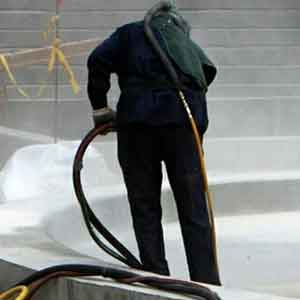
Sandblasting in layman’s term is described as the act of forcing very tiny bits of material at high speed and pressure to clean a surface or etch it. A sandblasting setup usually has three different parts: the abrasive itself, an air compressor, and a blaster nozzle. Forceful rubbing of abrasive caused by air compression against a material through a blaster nozzle causes chipping of the material’s surface. Sandblasting started with usage of sand as its primary material to etch surfaces but nowadays other materials that are nontoxic and safe to human working are being commonly used in its place.
These days, the glass windows that bear designs of flower patterns in grainy texture, office walls showing translucent borders and a reception area that depicts formal designs show the best utilization of sandblasting. The blasting material should also be hard and could include various substances like steel grit, walnut shells, or powered abrasives. More importantly, sandblasting is something that requires perfect handling and caution. Sandblasting involves high pressure to throw grit out of the blasting machine directly onto the surface intended to etch. However, these small grains of dust require to be performed under strenuous safety measures which includes complete cover of the nose to avoid any respiratory disease as high amount of material is still surrounded as small patches in the air and are very easily infiltrated in the lungs causing serious health concerns. Therefore, proper system is essential to start with before using a sandblaster. When sandblasting started, constant inhalation of silica caused workers silicosis as it was the main material in 1918 even though an exhaust fan were used to suction it out from the worker’s face.
Full body suit: It was introduced later on basically made of leather or canvas. The suit covers the entire body from any sort of allergic reaction arising out of blasting material in the air.
Protective eye glasses: Wearing of protective eye gear avoids splinters hitting the retina. These glasses are made of durable material that is resistant to hard substances which emanate out of the blaster. So it give the eyes total security from machine work.
Proper air outlet: Due to huge collection of dust in the workplace, basements are more prone to air outlet obstruction since there is the least passage of air in and out of the room. The prerequisite to installing a suitable ventilation system becomes prime that eradicates smoke from a sandblasting machine in toto. An alternate air supply installed thereof is beneficial and becomes necessary for safety.

Helmet ventilation blower system: The worker needs to wear a hood that has a preinstalled head suspension system to allow the device to move with the operator's head and a face window with lens protection and an air-feed hose connected to the helmet to supply fresh and filtered air directly to the helmet and prevent him from intake of hazardous media.
Hearing protection: Just like body protection that usually consists of gloves and leather chaps, professionals use ear plugs or muffs to protect the ear from constant high pitch noise that could damage their eardrums. Wearing of proper hearing protection can greatly reduce such risks and promote a healthy living atmosphere amongst the workers.
Moisture separator Moisture can build up in the media due to humidity present in it and can ultimately obstruct the proper flow of blast leading to damage to the machinery. A good moisture separator as close to the sand blast nozzle will filter the excess water from the incoming air supply and improve work efficiency. Regular cleaning of the separator will ensure a trouble-free operation
Proper gritting material: There are many cheap alternatives that workers go in for instead of recommended blasting material.Being costless, such media requires large quantities of grit to cover a small area and puts stress on the machine’s working.Quality material only gives good results.
Self-contained oil-less air pump: The air feed hose is attached to a grade D pressurized air supply unit. It has a pressure regulator, air filtration and a carbon monoxide alarm. An oil-less air pump feeds pressurized clean air to the helmetthat is free of carbon monoxide.
Definitely going by these steps, one can proficiently get good results out of the techniques classified above for a sustained and cost less operation.
